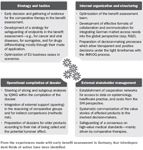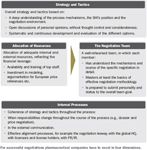Germany's Price Reform Revolution
At two years and counting, what's the secret of success in negotiating pricing under the new AMNOG legislation?
The Introduction in January 2011 of the Act on Reform of the Market for Pharmaceutical Products (AMNOG) has transformed the German pharmaceutical business like no law before, with significant long-term implications for the way companies develop and commercialize their products, not only in Europe (where 19 countries use Germany as the reference point for local pricing) but globally as well. Prior to last year, pricing for new drugs was basically free at time of launch; AMNOG drastically changed the equation by introducing an administratively-complex pricing system based on evidence of a new drug's additional benefit over established, often generic therapy. Now that we have nearly two years of practical exposure to the law, with more than 30 drugs assessed under the new rules, it's useful to examine some key precedents that will shape the pricing environment going forward.

( PHOTO: THINKSTOCK)
Different path to profits
The government expects the new law to generate savings for the statutory health insurance system of up to €2 billion annually. This objective illustrates the pricing pressures now facing research-based pharmaceutical companies. The new framework for price negotiations is widely forecast to reduce industry revenues, not just for drugs under review but across the entire therapeutic portfolio. Achieving a raise in net income for a drug by a few percentage points will require significant long-term investments in infrastructure around a new model for establishing and maintaining market access—one that depends less on marketing savvy aimed at patients and providers than on the capacity to build evidence and establish outcomes with direct appeal to a small community of payers.
Progress of the law to date is not encouraging. The first assessments under the new law had hardly begun when two big multinational drugmakers announced that because of the evidence requirements their products would not be made available to the German market. Novartis withdrew its antihypertensive drug Rasilamlo (Aliskiren/Amlodipin) after only four months, while Boehringer Ingelheim and Eli Lilly acted to forgo the price negotiation for their new anti-diabetic agent Tradjenta (Linagliptin). The decisions seemed to confirm the initial apprehension of industry about how AMNOG would hinder pharmaceutical innovations, especially if a negative assessment caused other countries to adopt the same position, thus depressing global sales projections. Actions by the three companies were subsequently echoed by Pfizer and GSK, who after a negative assessment decided not to negotiate and withdraw the hand contracture drug Xiapex and the anti-epileptic Trobalt, respectively.
What the record shows
Nevertheless, over 30 benefit assessments have been published to date. At least four launch prices have so far been negotiated, of which two are known—and these are 19 percent and 27 percent below list price. The net result is more clarity about how the law will actually work, giving industry the opportunity to evaluate what factors lead to better outcomes. But more clarity has not changed the misgivings the industry has about the law, while some unanticipated political controversy surrounding the assessment of individual products is making for increased discomfort around what is supposed to be a purely technical exchange among authorized experts.
Indeed, what the assessment process has exposed is a deep fault line between the expectations of the pharmaceutical companies and those of the statutory health insurance system. In the assessment, a drug's additional benefit over the comparator is rated along a grid of one out of six grades, ranging from a "major," "significant," or "marginal" additional benefit, on the one end; to "not quantifiable," "no," or "smaller" additional benefit, on the other. In their dossiers submitted to regulators for review, pharmaceutical companies allocated the highest grade of "major additional benefit" to more than 75% of subgroups. In contrast, this grade was not allocated once by the formal assessment review body, the Institute for Quality and Efficiency in Health Care (IQWiG). Instead, "marginal" and "no" additional benefit have been the most common outcomes of IQWiG assessments.
Focus on "me too" drugs
For the national confederation of SHI's, this is a clear sign of the success of the new process, ratifying their premise that many newly-marketed pharmaceuticals are only me-too products with scant benefit over established therapies. The sick funds are eager to extend the new process beyond new medicines, which account for less than 2 percent of total healthcare expenditures.

Compiling a value dossier requires the management of interdisciplinary and complex processes.
Indeed, the sick funds see the greatest potential for savings from the assessment of drugs that are already established on the market. "The sales volumes at issue in the current negotiations are too confined," Johann-Magnus von Stackelberg, vice chairman of the SHI confederation, is quoted in press releases. "Significant savings can only be achieved when we start assessing drugs in the established market." On June 7, the sick funds got their wish when the Federal Joint Committee (G-BA), which administers the AMNOG law, called for the assessment of eight marketed diabetes products, including the Merck blockbuster Januvia. It is expected that new prices for these widely used medicines will be set by the fourth quarter of 2013, and the worst case scenario anticipates an average drop of about 90 percent—equivalent to the prices of a generic comparator.
The definition of a comparator product—specifically, whether this should include evaluating a patented innovative molecule against a generic equivalent—is the greatest source of discord for Big Pharma. Under the new pricing system, the price of the existing comparator is a key determinant of a new product's price. Because the price of the assessed drug is negotiated on the assumption that it will carry some form of premium against the price of the comparator, the higher the price of the comparator, the better the later-reimbursed price for the new entrant. Hence if the AMNOG law is viewed purely as an exercise to lower the nation's drugs bill, the SHI and G-BA have an incentive to choose a comparator with a low price.
The choice of comparator thus poses a real dilemma to a pharmaceutical company seeking access to the German patient population for a new product. By refusing to be evaluated against the comparator set by the G-BA, the drug's additional benefit will not be recognized, and by complying, the price level can be minimal. This was the rationale for each of the four companies that refused to enter price negotiations after a negative IQWiG evaluation and thus opted out of the German market. The prospect of having to adhere to the G-BA comparator meant being compared to a generic drug with a cost of a few cents per day, a bridge too far for most companies with a commitment to operating as a global business.
Modest adjustments in the works
It is not only the pharmaceutical industry that has expressed dissatisfaction with the new process. Pressure from patients and politicians resulted in legislative action earlier this year for a transitional rule that would give companies under selected conditions a second chance for an early benefit assessment. Boehringer Ingelheim and Eli Lilly are the first to make use of this regulation with their Tradjenta medicine for diabetes.
The concession, however modest, shows that even after two years the new system has not secured a consensus among the social partners, politicians, and individual companies. It is thus difficult to rate the long-term effects for the international pharmaceutical industry. Although small alterations to the process are likely, the basic framework of evidence based prospective and post approval price review is here to stay. Irrespective of size and business volume, pharmaceutical companies must continue the work of setting up the structures, strategies, and expertise to receive positive results in the early benefit assessment—for both newly-marketed or established drugs.
How to cope: strategic recommendations for companies
Preparation of the value dossier. The importance of the value dossier required of applicants under the law cannot be overestimated. It forms the core of the complex price formation process—it is used as reference from the benefit assessment to the price negotiation and arbitration. Arguments and perspectives not included or supported in the dossier can be introduced later as well, but the law provides little guidance as to whether this evidence will prove decisive at the final price negotiation phase.

From the experiences made with early benefit assessment in Germany, four interdependent fields of action have been identified.
To ensure the value dossier meets the law's criteria and makes the best case for the product under review, four aspects have to be considered:
» Develop a baseline value argument and apply it consistently. Explain thoroughly the clinical benefits of the drug and frame your argument on the basis of the health and treatment outcomes most relevant to the local patient population. To increase the drug's chances of success, anticipate and address the perspective of the statutory health insurance funds, as the key player and ultimate decision maker.
» Collect and incorporate comprehensive healthcare data. The evidence needed to support a strong value proposition constitutes a significant logistical challenge. Participants in the assessment process contend that companies have failed to verify their proposed additional benefit by not providing relevant epidemiological, healthcare, and budget impact data. Amassing the evidence required to satisfy the pricing gatekeepers is a task that must be introduced into company clinical development programs as early as possible. Evidence from randomized clinical trials used to win authorization from the FDA or EMA will have to be accompanied by additional data to secure an acceptable price. A value dossier that consists of material drawn mainly from an NDA package of evidence from prospective trials against placebo may end up being used to justify a price at generic levels.
» Invest to demonstrate strong methodological certainty and expertise. A methodologically clear presentation of the evidence that is resistant to challenge is crucial. A common phenomenon in IQWiG assessment of the dossiers is harsh scrutiny of endpoints and a critical evaluation of subgroups presented by the pharmaceutical companies. Considering the downstream effects of a poor benefit assessment, an investment in methodological, and technical expertise is going to be more important to success than money spent on promotion materials under the old market conditions.
» Build an internal organization that reflects the new requirements for price approval. Market access and health economics should be designated core functions and coordinated with other mission critical activities like R&D, commercial development and business development, and licensing. Although companies realize this, there are practical tensions in coordinating and modulating rivalries among competing interests, which means that the necessary skills and expertise are often not effectively brought to bear in making the best case.
Make use of the hearing procedure. Besides the value dossier itself, the pharmaceutical company has one other window of opportunity to shape decision-making: the hearing procedure. In its assessment, IQWiG rates the extent of a drug's additional benefit over the designated comparator product. However, the final decision on additional benefit is taken by the G-BA. Before this decision is taken, an official hearing enables all affected players to be heard. In several cases, IQWiG's proposed rating has been altered by the G-BA, both up and down, based on arguments that were put forward in the hearing procedure. The transparency accorded here is an opportunity for companies to make their own case with arguments that embellish the dossier.
Build a stakeholder management map. By understanding the interests of all the relevant stakeholders, the pharmaceutical company can ensure that both the health context and the clinical benefit of its product are understood prior to the hearing. Detailed knowledge of the local realities and practices of care and the different perspectives of patients, payers, and physicians can foster coalitions to bolster the case for an optimal outcome in the assessment and the negotiation process; this alone makes a comprehensive stakeholder management strategy worthwhile.

For successful negotiations pharmaceutical companies have to excel in four dimensions.
Preparing and conducting the price negotiation. In contrast to the decision-making process on additional benefit, only two players are involved in the price negotiations: the statutory health insurance body and the pharmaceutical company itself. Currently, both parties have little experience when it comes to working within the new price framework under AMNOG, but the payer side is gaining experience at a much faster pace
Preparations for the price negotiation have to start early, ideally before the value dossier is handed in, to ensure that all essential information is included in the documents. The available internal resources and expertise have to be planned and interconnected to form a multidisciplinary negotiation team. The team has to excel both in terms of content and negotiation techniques. A clear and congruent story line should bring together the arguments from the dossier over the hearing procedure to the price negotiation and a potential arbitration. Qualitative and quantitative war gaming, mapping different scenarios, are tools to develop strong and resilient arguments.
However, good arguments must be accompanied by a strong presentation and that in turn demands a team that can function with confidence under conditions of intense emotional pressure. Therefore, roles in the team have to be clearly set out and rehearsed, as there is little room for improvisation. Team building exercises, training in negotiation and rhetorical skills, and anticipatory definition of each team member's leeway in decision-making are all important in securing a positive result.
Finally, although the reform primarily targets the pharmaceutical industry, it reinforces the importance of a close interdependence of all players in the healthcare sector. Recognition and incorporation of multiple perspectives optimizes the prospects of success in the process created by AMNOG. It is vital that pharmaceutical companies open up, strengthen their networking, and develop their understanding of the views of their counterparts in the new pricing-process. It is the lack of an overall strategic view of the healthcare market that will limit the capacity to manage the new environment in Germany.
Melanie Hager and Thomas Temme are senior consultants at the strategy consulting firm SKC Beratungsgesellschaft in Hannover, Germany. Matthias Schönermark is Professor of Manage-ment at the Hannover Medical School and CEO of SKC. He can be reached at schoenermark@skc-beratung.de.
Navigating Distrust: Pharma in the Age of Social Media
February 18th 2025Ian Baer, Founder and CEO of Sooth, discusses how the growing distrust in social media will impact industry marketing strategies and the relationships between pharmaceutical companies and the patients they aim to serve. He also explains dark social, how to combat misinformation, closing the trust gap, and more.

.png&w=3840&q=75)

.png&w=3840&q=75)



.png&w=3840&q=75)



.png&w=3840&q=75)















